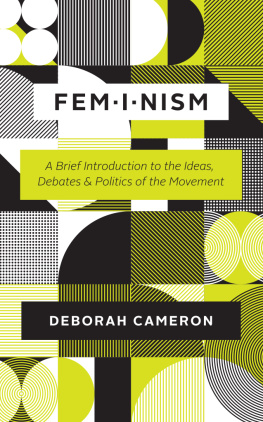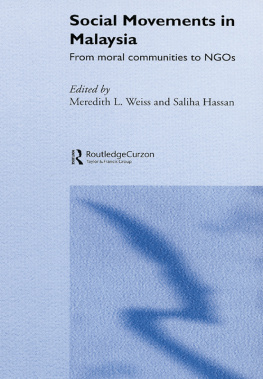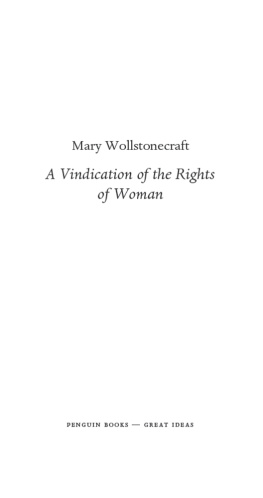Routledge Library Editions: Womens History
The Woman Movement
First published in 1969
This edition first published in 2013
by Routledge
2 Park Square, Milton Park, Abingdon, Oxon, OX14 4RN
Simultaneously published in the USA and Canada
by Routledge
711 Third Avenue, New York, NY 10017
Routledge is an imprint of the Taylor & Francis Group, an informa business
1969 George Allen & Unwin Ltd
All rights reserved. No part of this book may be reprinted or reproduced or utilised in any form or by any electronic, mechanical, or other means, now known or hereafter invented, including photocopying and recording, or in any information storage or retrieval system, without permission in writing from the publishers.
Trademark notice: Product or corporate names may be trademarks or registered trademarks, and are used only for identification and explanation without intent to infringe.
British Library Cataloguing in Publication Data
A catalogue record for this book is available from the British Library
ISBN: 978-0-415-53409-3 (Set)
eISBN: 978-0-203-10425-5 (Set)
ISBN: 978-0-415-62638-5 (Volume 31)
eISBN: 978-0-203-10281-7 (Volume 31)
Publishers Note
The publisher has gone to great lengths to ensure the quality of this reprint but points out that some imperfections in the original copies may be apparent.
Disclaimer
The publisher has made every effort to trace copyright holders and would welcome correspondence from those they have been unable to trace.
FIRST PUBLISHED IN 1969
This book is copyright under the Berne Convention. Apart from any fair dealing for the purposes of private study, research, criticism or review, as permitted under the Copyright Act, 1956, no portion may be reproduced by any process without written permission. Enquiries should be addressed to the publisher.
George Allen & Unwin Ltd, 1969
SBN 04 396005 7 cloth
SBN 04 396006 5 paper
PRINTED IN GREAT BRITAIN
in 10 on 11 point Plantin type
BY WILLMER BROTHERS LIMITED
BIRKENHEAD
The reader and the teacher of history might be forgiven for thinking that there are now too many series of historical documents in existence, all claiming to offer light on particular problems and all able to fulfil their claims. At any rate, the general editor of yet another series feels obliged to explain why he is helping one more collection of such volumes into existence.
One purpose of this series is to put at the disposal of the student original materials illustrating historical problems, but this is no longer anything out of the way. A little less usual is the decision to admit every sort of historical question: there are no barriers of time or place or theme. However, what really distinguishes this enterprise is the fact that it combines generous collections of documents with introductory essays long enough to explore the theme widely and deeply. In the doctrine of educationalists, it is the original documents that should be given to the student; in the experience of teachers, documents thrown naked before the untrained mind turn from pearls to paste. The study of history cannot be confined either to the learning up of results without a consideration of the foundations, or to a review of those foundations without the assistance of the expert mind. The task of teaching involves explanation and instruction, and these volumes recognize this possibly unfashionable fact. Beyond that, they enable the writers to say new and important things about their subject matter: to write history of an exploratory kind, which is the only important historical writing there is.
As a result, each volume will be a historical monograph worth the attention which all such monographs deserve, and each volume will stand on its own. While the format of the series is uniform, the contents will vary according to need. Some problems require the reconsideration which makes the known enlighteningly new; others need the attention of original research; yet others will have to enter controversy because the prevailing notions on many historical questions are demonstrably wrong. The authors of this series are free to treat their subject in whatever manner it seems to them to require. They will present some of their evidence for inspection and help the learner to see how history is written, but they will themselves also write history.
G.R.E.
Contents
Introduction
This essay endeavours to explain the course of feminist development in America and, to a much lesser extent, in England during the past century and a half The American material derives from my own research, the value of which readers will soon be able to judge for themselves when my Everyone was Brave: The Rise and Fall of Feminism in America is published (by Quandrangle Books). The English material is derivative. There is abundant printed matter on the English womens movement available in the United States, and I have gone through much of it, but as every scholar realizes, there is no substitute for a close familiarity with the primary sources. I do not pretend, therefore, to have anything new to reveal about English feminism. All the same, I have found it valuable to view the movement in both countries from a common vantage point. Since the beginning there has been a trans-Atlantic flow of people and ideas in both directions. While feminists in each country responded first of all to local conditions, neither movement grew up in isolation. Some knowledge of these reciprocal influences is necessary to understand fully what was happening in either country at any given time. Moreover, by comparing the two groups one gains a better understanding of what was distinctive about each, as well as some idea about the peculiarities of the societies to which they belonged.
Since this book is intended for an Anglo-American audience a further word of explanation is in order. In some instances I have felt obliged to explain what to many readers will seem common knowledge. But what is obvious in one country is often obscure in another. To take a simple example, few Americans realize that a Bill must pass three readings in each House of Parliament before it becomes law. On the other hand, how many Englishmen know that a Bill need only secure a majority once in each chamber of Congress? Apart from differences in spelling (labor-labour), usages sometimes cause trouble. In America all the people and activities which helped in any way to expand the role of women were known collectively as the Woman Movement. In England the preferred term for this was the Womens Movement. Similarly, Americans spoke of the Womans Rights Movement and woman suffrage, English people of the Womens Rights Movement and womens suffrage. The advocates of votes for women were known in both countries as Suffragists. In England the term Suffragette was coined to describe the militant followers of Emmeline Pankhurst. First used as an epithet, it was later adopted by the English militants to distinguish themselves from orthodox feminists. In America, however, Suffragette was nearly always a derisive label. I have generally tried to use the terms favoured by the women themselves, with one important exception. Feminists did not distinguish between those women who put womans rights before everything else, and those who favoured woman suffrage and the like in order to advance other interests. But after 1920 this distinction became crucial, and so I have coined the term social feminist to identify those women who placed particular social reforms ahead of womans rights. In both countries they were far more numerous than the militant (or radical, or extreme, or hard-core) feminists.






